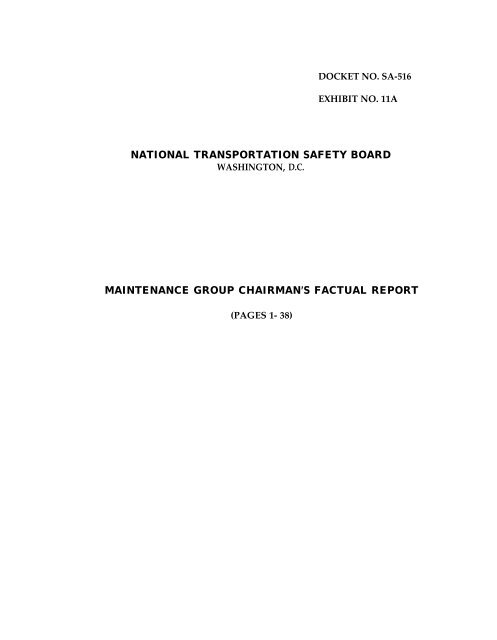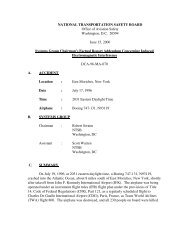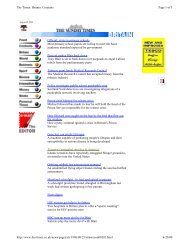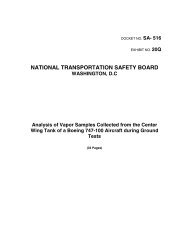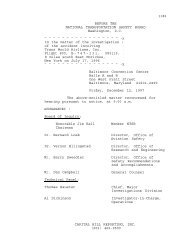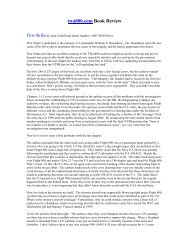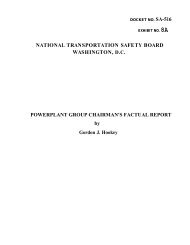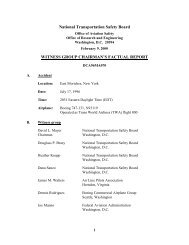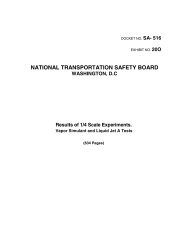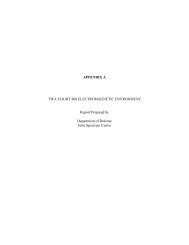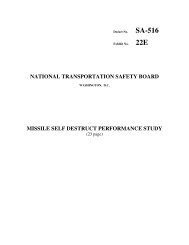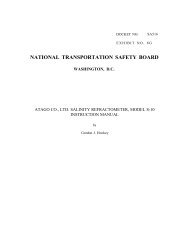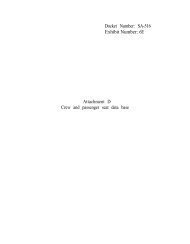Exhibit No. 11A - Group Chairman Factual Report - TWA Flight 800 ...
Exhibit No. 11A - Group Chairman Factual Report - TWA Flight 800 ...
Exhibit No. 11A - Group Chairman Factual Report - TWA Flight 800 ...
Create successful ePaper yourself
Turn your PDF publications into a flip-book with our unique Google optimized e-Paper software.
DOCKET NO. SA-516EXHIBIT NO. <strong>11A</strong>NATIONAL TRANSPORTATION SAFETY BOARDWASHINGTON, D.C.MAINTENANCE GROUP CHAIRMAN’S FACTUAL REPORT(PAGES 1- 38)
The Aircraft Maintenance Logbook is the official source of aircraft and cabin malfunctions. It isrequired by Federal Aviation Administration (FAA) regulations and must be on board the aircraft atdeparture. The multi-page aircraft logbook sheets are used by the flight crew and maintenance personnelto record aircraft malfunctions, work performed, and flight data. Each logbook contains 50 sets of prenumberedpages. It also contains Logbook Maintenance Deferral Item Control sheets. Logbook pagesinclude a yellow original, which is maintained as a permanent record, a blue copy used as a computerentry worksheet, and a white copy which is sent to Kansas City (MCI) maintenance records.The yellow pages remain in the logbook until either an Aircraft Service (AS), which is accomplished atintervals not to exceed 100 hours of aircraft time in service; a Time Control Service (TCS), which isaccomplished in sequence at intervals not to exceed 1,200 hours of aircraft service; or at a Check “C”,which is accomplished in sequence at intervals not to exceed 13 months.The last AS for the accident airplane was performed on July 13, 1996. At that time, all of the usedyellow logbook pages were pulled out and audited for complete sign-off and/or proper deferral. Theyellow sheets were then forwarded to Kansas City (MCI). The last page in the book was used at that timeand ended the book with number 19650. A new book was started, and the numbering began with 62551.There had not been another AS, TCS, or Check “C” performed after that date up to the time of theaccident, therefore, all of the yellow aircraft logbook pages starting with 62551 remained in the aircraft atthe time of the accident.If a deferral item is entered in the aircraft logbook, the blue logbook page is removed at that time, andthe information is entered into the AMPS as soon as practical, but not to exceed one hour after the aircraftdeparts. The blue copy is used as a computer entry worksheet and can be discarded after the informationhas been entered into AMPS. On July 17, 1996, the blue tear-out pages had not yet been discarded foraircraft logbook pages 62565 thru 62570, and were made available for review. See Deferred MaintenanceWrite-ups on the Open Item Work Sheet for details.Additional guidelines for the following areas can be found in <strong>TWA</strong> General Policies and ProceduresManual 1-10-0:1. Routine Maintenance - Scheduling and Control2. Guidelines Common to All Work3. <strong>No</strong>n-Routine Maintenance Handling4. Logbook Procedures5. Preparing Paperwork for Maintenance Operations6. Handling of Completed Paperwork747 MAINTENANCE AND INSPECTION PERIODSStructural Inspections<strong>TWA</strong>’s Structural Inspection Program and the Corrosion Prevention and Control Programs werereviewed to determine the procedures for compliance with these programs. <strong>TWA</strong>’s structural inspectionof the aircraft is performed in accordance with the <strong>TWA</strong> Boeing 747 Structural Inspection Program, asdetailed in <strong>TWA</strong> Engineering <strong>Report</strong> (ER) Number 1564.Supplemental Structural Inspections and Tasks required by the Boeing 747-100/200 SupplementalStructural Inspection Document are set forth in <strong>TWA</strong> ER 1713. The Corrosion Prevention and ControlProgram is detailed in <strong>TWA</strong> ER 1832.4
<strong>TWA</strong>’s baseline structural inspections (applicable to all <strong>TWA</strong> Boeing 747 aircraft) are incorporatedinto the following programs. The Check “C” program (OP 9) is accomplished at intervals not to exceed13 months. The OP 16 unit changes and structural checks are accomplished at intervals not to exceed 4years. The OP 11 incorporates tasks that are required as part of the 747 Corrosion Prevention andControl Program. These tasks are required at multiple two-year increments and are to be accomplished atCheck “C” - “2C”, and at OP 16 visits. The OP 1 is accomplished at intervals not to exceed eight yearsand must be accomplished in conjunction with an OP 16 visit.The OP 4, 5, 6, 7, and 8 contain the inspection requirements which are to be accomplished as specifiedfor the baseline structural percentage sampling program.The OP 2 contains tasks taken from the Boeing 747 Supplemental Structural Inspection Document(SSID), as described in <strong>TWA</strong> ER 1713, applicable only to certain “candidate” aircraft. OP 2 tasks arescheduled at Check “C” 2E (26 months), OP 16 (4 years), and OP 1 (8 years) on these “candidate”aircraft. Aircraft N93119 was not a “candidate” aircraft.Periodic Service (PS) CheckThe PS is accomplished at scheduled layovers of six hours or more at stations staffed by <strong>TWA</strong>mechanics, or every other operating day maximum, unless a higher maintenance level is accomplished.Routine work required for the PS is listed on Form M47-00-01. A PS incorporates checks for the cockpitand cabin; aircraft exterior; and a final check. The last PS performed on the airplane prior to the accidentwas on July 17, 1996, at JFK before the departure of <strong>Flight</strong> <strong>800</strong>.(<strong>Exhibit</strong> B - Periodic Service)Aircraft Service (AS) CheckThe AS is accomplished at intervals not to exceed 100 hours of aircraft time in service. It includes, inaddition, all work items performed at the PS. Routine work required at the AS are listed on Forms M47-00-XX. The AS forms are numbered 1 thru 6 and are identified as AS-1 thru AS-6, and are accomplishedin sequence until a Time Control Service is accomplished. The AS incorporates checks for the cockpitand cabin, exterior fuselage, wings, gear and empennage; engines and struts; oil, hydraulic, waterservicing, and fuel tank sumping; and a final check.The last AS-1 was accomplished on July 13, 1996, at JFK after the landing of <strong>Flight</strong> 803.(<strong>Exhibit</strong> C - Aircraft Service)Time Control Service (’TCS)The TCS is accomplished at intervals not to exceed 1,200 hours of aircraft service. The TCS zeros theAS checks, and the TCS is zeroed by the Check “C” and the OP 16. Routine work is accomplished onForm M47-00-03.The last TCS was accomplished on April 15, 1996, at JFK.(<strong>Exhibit</strong> D - Time Control Service)5
The Scheduled Maintenance Worksheets were reviewed for the period of July 1, 1994 through July17, 1996, to verify accomplishment of the scheduled maintenance at the appropriate time intervals.The Minimum Equipment List (MEL) and Configuration Deviation List (CDL) records were reviewedto verify accomplishment of the maintenance tasks and to identify the deferred items that remained openat the time of the accident. In addition, a list of all of the Airworthiness Directives (AD) and the Openand Completed Modification Orders for the aircraft were obtained to identify the ADs and ModificationOrders applicable to the center wing section, and to verify compliance of each AD against the aircraft.ATA code entries and the Work Card Control Master Index were used to identify which work cards werescheduled at the various Check C’s and last Check D.N93 119 BASIC AIRCRAFT AND ENGINE DATAAIRFRAME INFORMATION7Registration NumberYear ManufacturedSerial NumberPut Into Service at <strong>TWA</strong>Aircraft Total Time:Aircraft Total Cycles:Date of Last “D” CheckDate of Last “C” CheckN93119July 19712008310/27/7193,303 Hours16,869 CyclesDecember 14, 1992<strong>No</strong>vember 6, 1995ENGINE INFORMATIONENGINE #1Serial Number 662209Date Installed December 31, 1995Total Time Since Overhaul: 47,989 HoursTotal Cycles Since Overhaul: 9,684 CyclesCycles Remaining5,792 CyclesENGINE #2Serial Number: 662593Date Installed December 6, 1995Total Time Since Overhaul: 80,884 HoursTotal Cycles Since Overhaul: 14,609 CyclesCycles Remaining3,474 CyclesENGINE #3Serial Number 662426Date Installed June 18, 1996Total Time Since Overhaul: 80,336 HoursTotal Cycles Since Overhaul: 14,632 CyclesCycles Remaining5,945 Cycles
ENGINE #4Serial Number 662463Date Installed May 11, 1996Total Time Since Overhaul: 77,061 HoursTotal Cycles Since Overhaul: 14,016 CyclesCycles Remaining8,686 CyclesAIRCRAFT HISTORY<strong>TWA</strong> purchased the aircraft new from the Boeing Company and added it to the <strong>TWA</strong> certificate onOctober 27, 1971. The aircraft was utilized as a commercial transport until the aircraft was sold to Iranon December 15, 1975. Numerous modifications and maintenance were performed on the aircraft in1975, in preparation for the sale to Iran. Those modifications and inspections are listed in the followingtext.Modifications/inspections Completed Januaryv19751. Check flap control handle.2. Check auxiliary power unit bleed air duct.3. Check main flap carriage spindle nut torque.4. Inspect trailing edge flap foreflap sequence carriageModifications/Inspections Completed February 19751. Deactivate beverage bar blender.2. Check #3 bearing breather temperature.Modifications/Inspections Completed March 19751. Placard brew cup plate caution.2. Inspect trailing edge jackscrew and rerig snubber.Modifications/Inspections Completed April 19751.2.3.4.5.6.7.8.9.10.11.12.13.14.15.16.17.Check lavatory fire containment.Complete first class cabin modification.Install aural warning for leading edge flaps.Check wing gear truck bumper pads.Check continuous water scavenging system.Check auto spoiler control circuit.Revise normal static system plumbing.Check pitot/static tubing drain fitting.Modify ATC transponder to meet TSO-C74 B/C requirement.Check #2 auxiliary pitot tubing.Deactivate left assembly pillow storage compartment.Wire installation sidewall ceiling to shelf.Rework attendant seat and shelf.Install ground proximity warning system.Modify forward electric door.Install windshield overheat test switch guard.Relocate flap control unit spring.
18. Check auto spoiler control circuit.19. Improve cabin interphone system20. Permanent repair of #2 side cowl due to #2 engine failure in flight.Modifications/Inspections Completed in Mav 19751. Check seat belt attach fitting.Modifications/Inspections Completed in June 19751. Install hex table secondary latch.Modifications/Inspections Completed in August 19751. Perform check of passenger entertainment system/passenger service system multiplex system.Modifications/Inspections Completed in September 19751. Check temperature total 2 sensor lines.2. Change auto tape annunciator program.3. Deactivate understair bar waste container system.4. Check throttle control cable/rack endplay.Modifications/Inspections Completed in October 19751. Modify toilet flush pump motor.Modifications/Inspections Completed in December 19751. Reinforce wing lower aft splice plate.2, Modify right hand side cowl panel bleed port.3. Remove and install rudder ratio changer actuator/control unit.4. Modify water injection tank.5. Replace airborne vibration monitor light plate.6. Remove electric/electronic equipment for Iran 747 aircraft.7. Remove passenger cabin items for Iran 747.Electrical/electronic equipment included: removal of the in-flight movie projectors/elevators andscreen/mural assemblies from all zones; removal of galley ovens from all zones; removal of the cabininterphone handsets from the main deck only.The cabin passenger items included: examining all upper-lounge furnishings for condition, and repairall items as necessary; check lavatories for condition and operation; remove <strong>TWA</strong> logos from the tail andforward fuselage exterior. Several cabin items were removed from the aircraft and included items such as:tray carts, liquor modules, waste containers, cup dispensers, tray carriers, utility and beverage carriers,seat belt extensions, demo oxygen masks and life vests, portable oxygen cylinders, life rafts and life vests,first aid kits, cargo nets and assemblies.After the modifications were completed at <strong>TWA</strong>, the aircraft was ferried to the Boeing MilitaryAircraft Company, Wichita, Kansas, for further modifications prior to acceptance by Iran,
<strong>TWA</strong> records indicate that when the aircraft left the <strong>TWA</strong> facility on 12/15/75, the aircraft total timewas 14556:44 hours and 3,250 landings. The modifications that were to be performed while the aircraftwas at the Boeing Company were not accomplished. The maintenance records indicate that no write-ups,modifications or maintenance tasks were performed while the airplane was in Wichita Kansas. Irannever took delivery of the airplane and it was returned to <strong>TWA</strong>’s certificate on December 16, 1976. Theairplane was returned with a total aircraft time of 14563:47 hours and 3,254 landings. Approximatelyseven hours of flight time had been accumulated on the aircraft during this period.After the aircraft was ferried back to the <strong>TWA</strong> facility, the maintenance records indicate that theaircraft was inspected for Airworthiness Directive compliance to return it to an airworthy condition priorto commercial transport service. The commercial passenger services, <strong>TWA</strong> logos, paint, interior cabinmaterials etc. were reinstalled prior to the aircraft returning to commercial service.HEAVY MAINTENANCE HISTORYMAINTENANCE RECORDS REVIEW FROM LAST “D CHECK TO JULY 17 1996Maintenance records were reviewed from the last major “D check, which was completed on December14, 1992, to the day of the accident on July 17, 1996. Phases 3A B, C, and D “C” checks were performedin May, July, August, and October, 1993. Phase 4A and B “C checks were performed in <strong>No</strong>vember1993, and February 1994. After these dates, <strong>TWA</strong> subsequently revised its Boeing 747 maintenanceprogram from a phased check “C” to an annual type “C” check. Annual “C” checks were performed onOctober 14, 1994 and <strong>No</strong>vember 6, 1995.During the review of the non-routine work cards, work performed in the area of the center wing fueltank from stations 1,000 to 1,300 were noted.“D” CHECK DATED 12/14/92The last “D” check prior to the accident began on September 28, 1992 and was completed onDecember 14, 1992. The total aircraft time was 80,267 hours, and the total cycles were 14,694 cycles,All routine and non-routine maintenance work cards were reviewed to identify work accomplished in thearea of the center wing section, center wing fuel tank, fuel pumps, fuel write-ups, and electrical write-ups.During this check, routine maintenance, as identified by work card numbers and listed in the <strong>TWA</strong>Operations Specifications Manual, was accomplished. Part of the inspection required the removal of allpassenger seats in order to remove the floor and side panels. The floor panels were washed and the taperesidue was removed. One floor panel was replaced from station 860 to 960 on the right side Theremainder of the floor panels were reinstalled after a tap check and visual inspection.New carpeting was installed at this time. <strong>No</strong>n-routine maintenance identified references to missingfasteners in the seat tracks that were corrected. One non-routine work card identified “3 each brokenwires below floor panel #179.” The broken wires were identified for the automatic disinfection system(fumigation system). The system was designed to fumigate the aircraft in the case of an infestation,however, the system was never used. Maintenance personnel deactivated the system and the wires wereremoved. Floor panel #179 is located at fuselage station 1440 through 1500, on the right side.There was a “detailed inspection” of the floor beams, structure and fuel barrier for their condition overthe wing center section, from fuselage station 1,042 to 1,241. A detailed inspection includes structure,fuel tubing, cables, wiring, and units exposed or visible through routine open up. There were no specificnon-routine write-ups found for this area.10
Four discrepancies were noted regarding the fuel pumps. Two of the discrepancies were noted in theleft wing. A fuel leak was found at the outboard and inboard boost pump cable feed-through for the #2fuel tank. The electric conduits were tightened and safetied for both pumps. One discrepancy noted thatthe #3 forward boost pump in the right wing was inoperative. Anew forward boost pump was installedand it was operationally checked. The last discrepancy noted that the left wing, #2 outboard fuel jettisonpump housing had a gouge, and corrosion was noted at the mating surface. The fuel jettison pumphousing was removed and replaced.Write-ups regarding the passenger air packs were numerous, however, the work accomplishedconsisted of “routine” duct leak checks that were accomplished in accordance with the maintenancemanual instructions.Inspection of the drain cavity at the canted bulkhead revealed minor surface corrosion and a pluggeddrain line at fuselage station 1,240. The corrosion was removed and the drain was unplugged.During the “D” check, the center wing fuel tank was “inspected in detail” by two <strong>TWA</strong> Inspectors.The Boeing 747 Maintenance Manual, chapters 28-11-00 and 12-09-08 were referenced to accomplish theinspection, The applicable manuals used to accomplish this task are located at the aircraft for theInspectors and mechanics to reference. <strong>TWA</strong> scheduled maintenance procedures indicate that the “D”check is the only time in which there is scheduled access to the interior of the center wing fuel tank.The routine work cards used to accomplish the detailed inspection for the center wing fuel tank were:A402 - Open Center TankA424 - Center Section Dry Bay Open-upC412 - Install Fuel Valves-Center TankC413 - Remove Fuel Valves-Center TankD450 - Inspect Wing Center TankD451 - Inspect Wing Center Tank Dry BayH402 - Close Center TankH424 - Close Center Fuselage and Tank(<strong>Exhibit</strong> E - Center Wing Tank Routine Work Cards)Work cards C412 and C413, identify the work performed for the engine cross feed check valves; thecenter tank scavenge check valve; the center tank scavenge pump inlet/removal check valve and the centertank jettison pump discharge check valves.The valves are removed from the aircraft and sent to the <strong>TWA</strong> maintenance shop for shop check andrepair as required. The fuel cross feed check valves and the center tank scavenge check valve were sent tothe shop and tested. During the test, the valves operationally checked within limitations and no partswere replaced.The work cards reference, in parenthesis, the number of o-rings to be used and their part numbers.The word “ordered” is hand written next to the reference.(<strong>Exhibit</strong> F - Check Valve Work Cards)The center tank jettison pump inlet/removal check valves and the center tank jettison pump dischargecheck valves are expendable valves and are not rotable parts. If the valve checks out as operational, it isthen put back into service. If the valve does not pass the test, it is discarded. <strong>TWA</strong> does not maintainshop records for expendable parts.11
Work Cards D450 andD451 direct the Inspector to “Detail Inspect All Items In Center Tank," and“Detail Inspect All Items In Center Tank Dry Bay.” The <strong>TWA</strong> General Policies and Procedures Manualdefines “Detailed Inspection” as:“The area inspection concept constitutes a very detailed inspection of the designated area,including but not limited to structures, tubing, cables, wiring, and any units exposed or visiblethrough routine open up. <strong>No</strong>rmal assistance to visual inspection will be used as required andmay consist of mirrors, magnifying glasses, dye penetrant checks or specialized non-destructivetest equipment where applicable.”During the “D” Check, there were no non-routine work cards generated for the center wing fuel tank,and there were no structural discrepancies reported for level 2 or 3 corrosion.The last unscheduled maintenance performed to the center wing fuel tank, after the “D” Check, werefor fuel pump removals and installations. The right side jettison pump was installed on May 15, 1995; theleft side jettison pump was installed on March 27, 1996, and the scavenge pump was installed on April22, 1996. Removal and installation of the center wing fuel tank fuel pumps does not require access to theinterior of the center wing fuel tank.INSPECTOR INFORMATIONCurrently, <strong>TWA</strong> employs 226 Inspectors system wide. Inspection personnel are staffed at Kansas City,MO (47 Airframe and 92 Engine Overhaul); St. Louis, MO, (40); Los Angeles, CA (23); New York, NY(21); and San Francisco, CA (3).The Inspectors are used to inspect mechanical integrity and/or work performed on all <strong>TWA</strong> aircraft,engines, and components to assure the required standards are met, Full-time inspectors must be properlytrained, qualified and authorized to perform inspections on <strong>TWA</strong> aircraft. The inspectors must possesvalid Airframe and Powerplant certificates, pass a visual acuity test, and have a minimum of 15 monthswith the company as a Mechanic. <strong>TWA</strong> promotes its inspectors from the Union (IAM) ranks of aircraftmechanics.Two inspectors performed the “detailed inspection” on the center wing fuel tank at the last “D” Check.Both inspectors signed-off on work cards D450 and D451 on October 6, 1992.Personnel records provided by <strong>TWA</strong> indicate that both inspectors had been employed with <strong>TWA</strong> sincethe mid 1960’s. One inspector retired from <strong>TWA</strong> on <strong>No</strong>vember 1, 1992, the other inspector retired onMay 1, 1997. Both inspectors have held Airframe and PowerPlant certifictes since 1970. One inspectorheld inspection authority since April 1977, and the other held inspection authority since <strong>No</strong>vember 1985.Training records indicate that both inspectors attended and passed the required courses as specified inthe General Policies and Procedures Manual.NON-ROUTINE MAINTENANCE PERFORMED AT “C” CHECKSA review of the non-routine work cards from the “C” checks after the last “D” check identifiedmaintenance work performed in the area of the center wing section. During the “C” checks, there are noscheduled internal center wing tank inspections. Access to the center wing tank, other than at the “D”check, would be performed “as needed” and identified as non-routine.12
13PHASE 3A “C” CHECK DATED 5/6/93During this inspection, a fuel jettison pump S/N: 2081 was installed. operational and leak checkswere performed.PHASE 3B “C” CHECK DATED 7/3/93During this inspection, several leaks at duct clamps and packs were noted. Routine maintenancecorrection actions were accomplished.PHASE 3C “C” CHECK DATED 8/13/93Write-ups for the <strong>No</strong>. 2 heat exchanger header access plate looseness were noted. Routinemaintenance leak checks were accomplished and the header plate was secured.During the Phase 3D dated 10/5/93, 4A dated 11/28/93, and 4B dated 2/1/94, “C” checks, there wereno non-routine write-ups between stations 1,000 and 1,300 for the center wing fuel tank or the packs.ANNUAL 2E “C” CHECK DATED 10/14/94All of the carpets and seat covers were changed per Modification Order71T72. The seat coverchanges were accomplished in phases during this check. Several write-ups of the packs identified leaks,and routine leak checks were accomplished.ANNUAL 3E “C” CHECK DATED 11/6/95Several write-ups regarding leak checks for the packs and the heat exchangers were noted. Routineleak checks were accomplished.Two new forward passenger oxygen bottles were installed, and a floor panel was removed under row28 and then reinstalled for access to a metal repair.FUEL PUMP MAINTENANCE HISTORYThere are 16 fuel pumps in the Boeing 747-131. Eight boost pumps are located with four in eachwing, six jettison pumps are located with two in each wing and two in the center wing fuel tank, onescavenge pump is located in the center wing fuel tank, and one auxiliary power unit DC pump is locatedin the left wing.The fuel scavenge pump, the APU DC fuel pump and the fuel boost pumps do not have an installationtime limit and remain in the aircraft until the pump is inoperative. An inoperative pump is sent to <strong>TWA</strong>’soverhaul/repair facility for inspection, repair/overhaul and testing. After the pump is signed-off asserviceable, it is either put back into service where needed, or prepared for storage per each fuel pump’soverhaul manual, storage and shipping requirements.The fuel jettison pump motors have a <strong>TWA</strong> 9,000 hour hard time limit. The 9,000 hour limit wasestablished by <strong>TWA</strong> more than 17 years ago after <strong>TWA</strong> determined that the mean time betweenunscheduled removal (MTBUR) for the pump was 11,352 hours. The 9,000 hour scheduled removal forthe pumps are at every second “C” check and at every “D” check. The intent of the 9,000 hour limit wasto reduce the number of premature and unscheduled removals.
According to the Minimum Equipment and Dispatch Procedures Manual, one jettison pump maybeinoperative, provided the takeoff weight does not exceed performance limitations determined by theengine-out maximum landing weight, the jettison nozzle remains closed, and the <strong>No</strong>. 1 and <strong>No</strong>. 4 maintank jettison transfer valves remain closed.A center wing jettison valve may be inoperative in the open position, provided that both jettison nozzlevalves operate normally and are closed. A center wing jettison valve maybe inoperative in the closedposition provided that the center tank fuel is considered as payload and all of the number 2 and 3 boostpumps operate normally.Number 1 and/or number 4 main tank jettison transfer valves maybe inoperative in the closedposition, provided fuel required to be jettisoned does not deplete the inboard main tanks below thequantity in the outboard main tanks plus 1 and 4 reserve tanks.The <strong>TWA</strong> Kansas City, MO, Maintenance Coordinator must approve the deferral of an inoperativejettison valve, and the fuel jettison switch cover (F/E panel) must be placarded “INOP.”MAINTENANCE HISTORY OF FUEL PUMPS INSTALLED ON N93119The maintenance history for each fuel pump is identified by <strong>TWA</strong> Component Shop Records. Eachrecord identifies the aircraft and date the pump was previously removed from. The discrepancy isrecorded, along with the work accomplished. The pump is then tested, signed off, and dated asserviceableThe following text identifies the previous pumps that were installed on N93119 and the reason forremoval, along with the most recent reason for removal, and the work accomplished on the pump that wascurrently installed onN93119 at the time of the accident1. Scavenge Pump - Serial number M285, was removed from N93119 on August 15, 1994, due to thepump being inoperative. During the overhaul, it was found that the bearings were worn, causing the rotorto rub, The stators, bearings, blades, valve housing liner and rotor were replaced, The pump was signedoffas overhauled on October 18, 1994, and tested on October 20, 1994. The pump was re-installed inN93 119 on April 22, 1996.2. APU DC Pump - Serial number M365, was removed from N133TW on April 2, 1990, as the pump wasinoperative. During the overhaul, it was found that the brushes were worn, and the rotor was damaged.The pump was signed-off as repaired on September 6, 1990, and tested on September 12, 1990. Thepump was installed in N93119 on April 15, 1996.3. Boost Pump - Serial number 711533, located in the left wing was installed new inN93119 onDecember 20, 1976. The pump remained operational, and there is no record of repair or overhaul.4. Boost Pump - Serial number 6<strong>800</strong>03, located in the left wing, was removed from N93105 onSeptember 16, 1993, due to an open fuse. The pump was repaired by replacing the fuse, rotor andpacking. The pump was signed-off as repaired on December 15, 1993, and tested on December 27, 1993.The pump was installed in N93119 on February 22, 1994.5. Boost Pump - Serial number 95309A located in the left wing, was removed from N134TW onDecember 23, 1991, due to the pump being inoperative. During the repair, it was found that the statorwas burned. The pump was signed-off as repaired and tested on March 2, 1992. The pump was installedin N93119, on March 13, 1992.14
6. Boost Pump - Serial number 000972, located in the left wing, was installed newinN93119 onDecember 20, 1976. The pump remained operational, and there is no record of repair or overhaul7. Boost Pump - Serial number 700763, located in the right wing, was removed from N305TW on June 8,1991, due to the pump being inoperative. During the repair, it was found that the rotor was scored. Thepump was signed off as repaired and tested on September 24, 1991. The pump was installedinN93119on October 14, 1991.8. Boost Pump - Serial number 711606, located in the right wing was installed new in N93119 onDecember 20, 1976. The pump remained operational and there is no record of repair or overhaul.9. Boost Pump - Serial number 690223, located in the right wing, was removed from N53110 on July 24,1990, due to a low pressure light. During the repair, it was found that the stator had shorted. The pumpwas signed-off as repaired on October 5, 1990, and tested on <strong>No</strong>vember 3, 1990. Maintenance recordsindicate that the pump was installed in N93119 on October 8, 1990. <strong>TWA</strong> maintenance personnel believethat the date was incorrectly noted, and the correct installation date was <strong>No</strong>vember 8, 1990.10. Boost Pump - Serial number 711604, located in the right wing, was installed new in N93119 onDecember, 20, 1976. The pump remained operational, and there is no record of repair or overhaul.11. Jettison Pump - Serial number 690469A, located in the center wing fuel tank, was removed fromN93108 due to an open fuse and the pump would not flow. During the overhaul, the stator, bearings, androtor were replaced. The pump was signed-off as overhauled on March 14, 1996, and tested on March 18,1996. The pump was installed inN93119 on March 27, 1996. At the time of the accident, the timeremaining for this pump was 7,730 hours, with an estimated run-out date of February 10, 1998.12. Jettison Pump - Serial number 690394, located in the center wing fuel tank, was removed fromN93108 due to time. During the overhaul, the bearings were replaced. The pump was signed-off asoverhauled on December 6, 1994, and tested on December 8, 1994. The pump was installed in N93119on May 15, 1995. At the time of the accident the time remaining for this pump was 4,588 hours, with anestimated run-out date of June 24, 1997.13. Jettison Pump - Serial number 700822, located in the left wing, was removed from N133TW due totime. During the overhaul, the bearings and impeller were replaced, and the elements were re-primed.During the build-up, the stator failed and was then repaired. The pump was signed-off as overhauled onFebruary 16, 1995, and tested on February 23, 1995. The pump was installed in N93119 on April 5,1995, At the time of the accident, the time remaining for this pump was 4,253 hours, with an estimatedrun-out date of May 30, 1997.14. Jettison Pump - Serial number 700934, located in the left wing, was removed from N134TW as thepressure light illuminated with the switch on. During the overhaul, it was found that the plating flakedoff the rotor, and there was evidence of short damage to the rotor bearings, and the stator fuse was blown.The stator, rotor, and bearings were all replaced. The pump was signed-off as overhauled on May 24,1995, and tested on May31, 1995. The pump was installed in N93119 on June 14, 1995. At the time ofthe accident, the time remaining for this pump was 4,886 hours, with an estimated run-out date of July 16,1997.15. Jettison Pump - Serial number 712059, located in the right wing, was removed from N93119 due totime. During the overhaul, the bearings and bearing holder were replaced. The pump was signed-off asoverhauled on May 25, 1994, and tested on May 1, 1995. The pump was re-installed in N93119 on May14, 1995, At the time of the accident, the time remaining for this pump was 4,573 hours, with anestimated run-out date of June 23, 1997.15
16. Jettison Pump - Serial number 790293, located in the right wing, was removed from N93108 due totime. During the overhaul, the rotor, bearings, both plates, and element were replaced. The pump wassigned-off as overhauled on August 8, 1995, and tested on August 28, 1995. The pump was installed inN93119 on September 10, 1995. At the time of the accident, the time remaining for this pump was 6,114hours, with an estimated run-out date of October 14, 1997.(<strong>Exhibit</strong> G - Component Shop Record Cards and Testing Cards).FUEL PUMP OVERHAUL PROCEDURES<strong>TWA</strong>’s Kansas City, MO, maintenance base has an overhaul/repair shop to refurbish all of the pumpsutilized for <strong>TWA</strong>’s entire Boeing 747 fleet.The jettison pumps and the boost pumps are manufactured by Crane Hydro-Aire Division. Thescavenge pump and the APU fuel pump are manufactured by Lear Romec, a division of Crane. The <strong>TWA</strong>maintenance base repaired and overhauled these pumps in accordance with the manufacturers’ overhaulmanuals and <strong>TWA</strong>’s reliability control program specifications established or approved by <strong>TWA</strong>engineering.APPLICABLE SERVICE BULLETINS AND AIRWORTHINESS DIRECTIVES FOR THE FUELPUMPSAirworthiness Directive (AD) 79-06-02, effective April 19, 1979, (<strong>Exhibit</strong> H) required compliance asidentified in Boeing Alert Service Bulletin (SB) 747-28A2092, dated February 12, 1979, (<strong>Exhibit</strong> I) andrevised April 27, 1979, The SB, entitled Main Fuel Tank Pump Wiring Inspection, Rework andModification, was a one-time accomplishment. The inspection, repair, and modification was to precludeelectrical arcing into the <strong>No</strong>. 2 and <strong>No</strong>. 3 main fuel tanks. This arcing could have resulted from darnagedwires which provide power to the <strong>No</strong>. 1 and <strong>No</strong>. 4 main fuel tank boost pumps. <strong>Report</strong>ed chafing andabrasion was attributed to vibration of the wires against the conduit wall. <strong>TWA</strong> records indicate that theAD was accomplished by <strong>TWA</strong> maintenance personnel on June 6, 1979.Since the accident, the FAA has issued AD 96-26-06, effective January 21, 1997, (<strong>Exhibit</strong> J) whichrequires a one-time inspection to detect damage to the sleeving and wire bundles of the boost pumps of thenumbers 1 and 4 main fuel tanks, and the auxiliary tank jettison pumps if installed, replacement of anydamaged sleeving with new sleeving; and repair or replacement of any damaged wires with new wires.The AD further states that if any burned wires are found, inspection of the conduit and replacement of theconduit (if damage is found) is required.The FAA determined that an environment conducive to vibration exists in the conduit and wirebundles of the boost pumps and the auxiliary tank jettison pumps. This vibration could result in abrasionsof the Teflon sleeving and subsequent abrasion to the wire bundles.Service Bulletin 747-28A2194, dated August 3, 1995, and revised January 18, 1996, (<strong>Exhibit</strong> K)entitled Fuel - Distribution - Fuel Boost and Override/Jettison Pumps - Inspection, indicated that theaction was to access all of the 747 boost and jettison pumps to do an insulation resistance check on eachpump. Any pumps that did not pass the insulation resistance check were to be replaced. Boeingrecommended that the initial inspection be accomplished at the next opportunity when manpower andfacilities were available.16
The Service Bulletin indicated that operators had reported fuel leaks on at least eight fuel pumps. Thepumps that were removed had between 34,000-67,000 hours since new or overhaul. The leaks werelocated at the pump/wire bundle interface. One operator reported a fire during maintenance at an inboardmain tank jettison pump which resulted from a leak.The Service Bulletin stated that ”... after a long time, water can get inside the potting of the wireterminal assembly and cause corrosion. The corrosion in the wire terminal assembly can cause arcingbetween the power pins and the pump case. The arcing causes thermal expansion of the materials insidethe cap. This expansion causes failure of the cap attachment flange or the attaching screws and asubsequent fuel leak.”A high current during arcing can also melt a hole through the pump end-case and connector, whichcould also create a leak.The Service Bulletin directed the test of the pump wiring insulation resistance to make sure that noconductive corrosion was in the wire terminal assembly.At the time of the maintenance review, <strong>TWA</strong> personnel reported that SB 747-2%42 194 had not beenaccomplished on N93119 because of a pending AD. Federal Aviation Administration <strong>No</strong>tice of ProposedRule Making (NPRM) <strong>No</strong>. 96-NM-57-AD (<strong>Exhibit</strong> L) (proposing an AD that was applicable to allBoeing Model 747 and 757 series airplanes.) Because of the pending AD, <strong>TWA</strong> was in the process ofpreparing <strong>TWA</strong> Modification Order Number 72F57, entitled Fuel Boost and Override/Jettison pumpInsulation Resistance Check. (<strong>Exhibit</strong> M). The modification order directed the initial inspection of the747 fuel pumps for leaks at the fuel pump/wire bundle interface, and to test the insulation resistance of thepump wiring to meet the requirements set forth in the pending AD, Service Bulletin, and Boeing Telexletters. <strong>TWA</strong> reported that the Modification Order was to be finalized after the AD became effective, incase there were changes made to the AD that were not identified in the SB.The proposed AD would “require repetitive visual inspections to detect discrepancies of the wireterminal assembly, electrical connector, and wire insulation on the fuel pump, and replacement of the fuelpump with a new fuel pump, if necessary."” The proposal would also require “repetitive insulationresistance test of the fuel pump wiring.”The pending AD became effective on March 14, 1997, as AD 97-03-17. (<strong>Exhibit</strong> N). <strong>TWA</strong>Modification Order 72F57 was finalized on April 1, 1997.FUEL PUMP WRITE-UPS FROM JULY 1, 1994 THROUGH JULY 17, 1996Aircraft Maintenance Log dated June 27, 1994, indicated that the number 2 main inboard jettisonpump low pressure light illuminated. The maintenance records indicate that the item was deferred andthe aircraft was placarded to show the inoperative pump. On July 2, 1994, maintenance personnelperformed an operational check to the low pressure indication system several times and the fault could notbe recreated.Aircraft Maintenance Log dated July 2, 1994, indicated that the scavenge pump low pressure lightilluminated with 2,100 pounds of fuel remaining in the center fuel tank. The center tank was sumped andthe scavenge pump operationally checked okay.Aircraft Maintenance Log dated July 3, 1994, indicated that the number 1 fuel tank aft boost pumppressure light illuminated with the pump on. The circuit breaker was re-seated and the systemoperationally checked normal.17/7
Aircraft Maintenance Log dated July 7, 1994, indicated that on pre-flight the flight crew reported aproblem with the number 1 aft boost pump. The aircraft was placarded and the item was deferred untilJuly 8, 1994, when the connector was reset and cleaned. The aft boost pump was checked for operationand light indication was normal.Aircraft Maintenance Log dated July 17, 1994, indicated that the number 1 aft boost pump low -pressure light will not go out with the pump on. The aircraft was placarded and the item was deferreduntil July 18, 1994. The system was trouble-shot and found that the pump was drawing amperage andtransferring fuel. Maintenance suspected the low-pressure switch. The number 1 all boost pump pressureswitch was replaced. The operation and checks for leaks were accomplished.Aircraft Maintenance Log dated August 10, 1994, indicated that the scavenge pump was inoperative.The item was deferred with a note: “Check 3 phase vac found good. Checked pressure light, found good.Checked vdc for coil, found good. Checked 1X on R296, found no ground with ground safe. Circuitbreaker was pulled.” The scavenge pump was replaced on August 14, 1994. Operations checked normal.Aircraft Maintenance Log dated September 12, 1994, indicated that the scavenge pump low-pressurelight illuminated with 2,300 pounds of fuel remaining in the center wing tank. The item was deferreduntil September 12, 1994, when the pressure switch was replaced. Leak and operation checks wereperformed.Aircraft Maintenance Log dated September 15, 1994, indicated that the scavenge pump low-pressurelight illuminated with 2,700 pounds of fuel remaining in the center tank. The light blinked on and offcontinuously during scavenge. Pump worked okay. The item was deferred until September 15, 1994,when relay R296 was replaced. An operations check was required when the center tank had fuel.Aircratt Maintenance Log dated October 19, 1994, indicated that the APU “DC pump ON” green lightflickering and chattering noise from under flight engineer’s table, right side. Number 2 boost pump isoperating. Re-seated and cleaned connector at number 2 boost pump. Checked operation of APU DCpump “on” light and found normal.Aircraft Maintenance Log dated February 2, 1995, indicated that the DC pump fails to extinguish withAC power available. Aft number 2 main Boost pump light extinguished. DC pump light did go out withforward boost pump on. The DC pump pressure switch plug was cleaned. An operations check of theAPU was normal,Aircraft Maintenance Log dated March 31, 1995, indicated that the APU DC pump “ON light(green), flicked on and off while the APU was running with normal AC electrical power available to fuelpump. The APU fuel control pressure switch was replaced. Operations checked normal.Aircraft Maintenance Log dated June 14, 1995, indicated that the center tank left outboard jettisonpump was changed for time. When the tank is fueled it will need a leak and operations check. The itemwas deferred until June 14, 1995. The item was entered incorrectly, and it should have been number 2main jettison pump, left outboard. This pump was leak and operationally checked after the aircraft wasfueled for flight 840.Aircraft Maintenance Log dated July 5, 1995, indicated that the number four main tank forward boostpump pressure light would not illuminate when the switch was off. The number four tank was sumpedand no water was found. The cannon plug on the pressure transmitter was cleaned. Operations checkednormal.18
After the accident on July 17, 1996, a mechanic reported to the National Transportation Safety BoardOperations <strong>Group</strong> <strong>Chairman</strong>, that during the fueling process for <strong>Flight</strong> <strong>800</strong>, at JFK, the fuel system shutdown. The mechanic reported that a circuit breaker was pulled and the pressure fueling process wascontinued. After the fueling was complete, the circuit breaker was reset. The mechanic reported than anentry in the Aircraft Maintenance Logbook was not made prior to the departure of the flight.Maintenance Manual Reference For Fueling DiscrepanciesThe 747 Maintenance Manual, section 12-11-01, Fuel Tank - Servicing, states that the airplane isnormally pressure fueled. The pressure fueling stations are located in the leading edge of each wingbetween the engine nacelles. The fueling station in the left wing contains the refueling control panel forcontrolling and monitoring the pressure fueling operation.This section identifies several problem solving procedures for maintenance personnel to follow in caseof a fuel system malfunctionThe manual states for a malfunctioning volumetric shutoff control unit that, “should dispatch timeprevent repair of a malfunctioning volumetric shutoff control unit, the shutoff system can be disabled byremoving the fuse in the volumetric shutoff control unit in the right main equipment center on shelf E3.This permits operation of the refuel valves and fuel quantity indicators, but disables the automaticvolumetric shutoff control unit. The fuel level shutoff must be controlled by the individual refuel valveswitches for all tanks.”The maintenance write-ups indicate that maintenance personnel were trouble-shooting the intermittentmalfunction by ordering and replacing specific items in the system. In the meantime, if a malfunctionoccurred, the aircraft could be pressure fueled by manually removing the fuse to disable the volumetricshutoff control unit.FUEL LEAKSThree aircraft logbook entries were noted indicating a fuel leak between July 1, 1994 and July 17,1996.Aircraft Maintenance Log dated September 23, 1995, indicated that during the walk-around, the flightengineer observed fuel dripping from the left wing dump chute (fueling was in process). The drip stoppedwith the termination of the fueling. Engineering note: This is an abnormal condition, possible dumpvalve problem. Pressure fuel system. Leaks were checked for and none were noticed.<strong>No</strong>n-Routine Maintenance Record dated June 18, 1996, indicated that fuel was found leaking from thefuel shut-off valve when checking cross-feed valve operation. This was recorded during an enginechange. The number three engine was removed because of an over-temperature and a replacement enginewas installed. During the engine preparation of the replacement engine, the cross-feed valve operation isto be checked. The particular engine boost pump circuit breaker is to be closed and an engine fuel shutoffcheck is to be accomplished per Maintenance Manual 28-22-05. Maintenance personnel transferred fuelinto the number three fuel tank and accomplished a shutoff valve check per Maintenance Manual 28-22-05 instructions. The write-up indicates that eight drops per minute were noted from the shut-off valve,which is within limits per the Maintenance Manual instructions which allows for leakage not to exceed 20drops per minute.21
Aircraft Maintenance Log dated February 11, 1995, indicated that the pilot’s number two fuel flowindicator read high. Fuel used indicated high from the engine start until takeoff. Ram bite test on fuelflow module was conducted per maintenance manual instructions. Operations checked normal.Aircraft Maintenance Log dated April 28, 1995, indicated that the fuel temperature indicator read lowin all positions. The item was deferred until April 29, 1995, when the fuel temperature indicator wasreplaced. Readings were 15 degrees low on tank, engine 1, engine 3, and engine 4. Read 20 degrees lowon engine 2.Aircraft Maintenance Log dated May 5, 1995, indicated that the fuel temperature indicator for engine2 read high by ten degrees C, when actual temperature was nearer to -10 degrees C. The item wasdeferred until May 6, 1995, when the fuel temperature bulb was replaced.Aircratl Maintenance Log dated May 18, 1995, indicated that the gross weight /total fuel weightindicator was inaccurate. The gauge read 1,500 pounds less than the sum of the tank gages. The itemwas deferred until May 21, 1995, when the operations checked within maintenance manual limits.Aircraft Maintenance Log dated July 30, 1995, indicated that the fuel quantity in the main tank,number one, decrease 2,000 pounds in four hours in cross-feed configuration. The totalizer matched fuelindicated in the tanks. The item was deferred until August 5, 1995, when the number one fuel quantityindicator was replaced. Full and empty capacitance were checked. The indicator to totalizer werecalibrated per maintenance manual references. All of the systems checked normal.Aircraft Maintenance Log dated August 3, 1995, indicated that an engineering note stated to placardthe number one fuel gauge inoperative. Suspected that the fuel gauge was okay, but that there was adefinite existing fuel problem. Suspect possibility of fuel siphoning from the number 1 tank (when boostPumps are off into fuel manifold. The aircraft was checked for external fuel leaks and none were found.Pressurized fuel manifolds and no transfer of fuel was noted. Checked the fuel burn for engine and allchecked normal. Engineering was notified and suspected the problem remains in the indication. Theitem was closed out on August21, 1995, during the AS-1 check. (NOTE The paperwork for the AS-1could not be located and suspect that it was misfiled).Aircraft Maintenance Log dated August 4, 1995, indicated that an engineering note stated that thecenter wing fuel quantity digital indicator showed 1,300 pounds when analog needle indicated 0. Theitem was deferred until August 5, 1995, when the center fuel quantity indicator was replaced. The filland empty capacitance was checked and the indicator and totalizer was calibrated per maintenancemanual instructions.Aircraft Maintenance Log dated August 5, 1995, indicated that the number 1 fuel quantity indicatorwas replaced. The full and empty capacitance were checked and the indicator and fuel totalizer werecalibrated.Aircraft Maintenance Log dated August 7, 1995, indicated that during the course of cross-feeding (4hours and 30 minutes), with the number one reserve tank valve closed and the boost pumps off in numberone main fuel tank, the fuel quantities dropped from 3,500 to 2,850 in number one reserve, and from21,700 to 19,100 in number one main tank. Fuel used plus fuel remaining equaled original fuel load, sothe gauge was reading correctly. The number one reserve tank was fueled and no transfer of fuel occurredwith the valve closed. Tank quantities were noted and no transfer was noted from number one or gain inother tanks. This was monitored for eight hours.23
Aircraft Maintenance Log dated August 15, 1995, indicated that the flight engineer’s fuel flowindicator was inoperative. Fuel used was okay. The forward panel fuel flow indicator was okay. Thenumber four fuel flow indicator was replaced. Operations checked okay.Aircraft Maintenance Log dated August 23, 1995, indicated that the number four fuel flow stuck at7,900 pounds. The pilot’s fuel flow were normal. The item was deferred until August 24, 1995, when thefuel flow indicator was removed and replaced.Aircraft Maintenance Log dated October 9, 1995, indicated in an Engineering <strong>No</strong>te that before fueling,fuel discrepancies between the wing gauges and flight engineers were to be checked. All of the tanks werechecked and the fuel sticks were all okay.<strong>No</strong>n-Routine Maintenance Record dated December 1, 1995, indicated that the number 1 engine fuelflow was inoperative. Maintenance performed a bite check of the fuel flow and all operations checkednormal.Aircraft Maintenance Log dated December 4, 1995, indicated that the number 1 fuel flow wasinoperative. The item was deferred until December 4, 1995, when the flight engineer’s fuel flow indicatorwas replaced. The number 1 fuel flow transmitter connector was cleaned. Operations was checked asnormal.Aircraft Maintenance Log dated December 17, 1995, indicated that the number 4 reserve quantityindication was inoperative. The item was deferred until December 17, 1995, when both wing and cockpitindicators were replaced and calibration was required. The cockpit and wings full/empty were calibrated.Volumetric operations checked normal.Aircraft Maintenance Log dated December 17, 1995, indicated that the center wing fuel tank gaugefluctuated between 2 and 0 with no fuel in the tank. The tank was sumped and the indicator calibrationfull/empty volumetric totalizer was replaced. Operations checked normal.Aircraft Maintenance Log dated December 28, 1995, indicated that the number 1 engine fuel flowfluctuates on. The item was deferred until January 1, 1996, when a bite check was performed on the fuelflow amperage.Aircraft Maintenance Log dated April 27, 1996, indicated that the number 1 fuel flow (numerals) read10,000 PPH above pointer value. The fuel used and pilot’s gauge were okay. The number 1 fuel flowindicator was replaced and the operations checked normal. Operations of the number 1 engine fuel flowat the engineer’s position was checked and found okay on start-up.Aircraft Maintenance Log dated May 13, 1996, indicated that both of the number 4 fuel flow indicatorswere pegged high and inoperative. The item was deferred until May 15, 1996, when maintenanceperformed a bite check of the electronic unit, All tests were passed and maintenance suspected wiring.On May 16, 1996, maintenance cleaned and secured the fuel flow transmitter connector with no helpindicated. On May 18, 1996, maintenance replaced the number 4 transmitter. After this, the engine fuelflow operations checked normal.24
25FUEL QUANTITY TANK UNITSThere are a total of 65 fuel quantity tank units probes, and 13 fuel quantity compensators locatedthroughout the 747-131 aircraft. The locations of the fuel quantity tank units are: four in the <strong>No</strong>. 1 and<strong>No</strong>. 4 reserve tanks; 13 in the <strong>No</strong>. 1 and <strong>No</strong>. 4 main fuel tanks; 12 in the <strong>No</strong>. 2 and <strong>No</strong>. 3 main fuel tanks;and seven are located in the center wing fuel tank.The fuel quantity compensators are located two in the <strong>No</strong>. 1 reserve tank; one in the <strong>No</strong>. 4 reservetank; one in each surge tank; two in the <strong>No</strong>. 1 and <strong>No</strong>. 4 main fuel tanks; two in the <strong>No</strong>. 2 main fuel tank;one in the <strong>No</strong>. 3 main fuel tank; and one in the center wing fuel tank.The fuel quantity tank units and compensators are “condition monitored” items and are removed fromthe airplane when the unit is inoperative. When an inoperative unit is identified, the unit is removed fromthe airplane and replaced with an airworthy unit. The inoperative unit is then sent to the <strong>TWA</strong>maintenance base in Kansas City for inspection.The fuel quantity tank units were manufactured by Honeywell. <strong>TWA</strong> inspects/repairs/overhauls theunits in accordance with the Honeywell overhaul manuals and <strong>TWA</strong>’s reliability control programspecifications established or approved by <strong>TWA</strong> engineering.<strong>TWA</strong> overhaul shop records indicate that all fuel quantity tank units and compensators installed inN93 119 are the original units that were installed during manufacture in 1971.Unless there is a malfunction of the fuel quantity tank units or compensators that requires unscheduledmaintenance, the units are inspected during the scheduled “D” Check.POWERPLANT REVIEWThe aircraft maintenance log was reviewed from July 1-17, 1996, and identified engine discrepanciesand the work accomplished. The following text identifies the engine write-ups.Engine position number 1, serial number 662209, was remwed from N93119 on June 26, 1995, for hotsection distress. The repair was performed at Kansas City (MCI) on <strong>No</strong>vember 16, 1995, and the enginewas re-installed, at New York (JFK), in position number 1 on December 31, 1995.Maintenance write-ups and work performed on the engine since July 1, 1996, were:● July 1, 1996- The Exhaust Gas Temperature (EGT) exceeded the limits to 920 degrees C for 90seconds. An inlet and exhaust inspection waa performed, along with a duct leak check. All wasreported as normal.● July 1, 1996- The EGT exceeded the limits to 920 degrees C for 30 seconds. This temperaturewas located in area “A” on the over-temperature chart. The over-temperature was caused by amaximum power takeoff. The maintenance records indicate that the number one EGT indicatorwas replaced. The inlet and exhaust were checked, inspected and found “okay.”● July 13, 1996- The number one Engine Pressure Ratio (EPR) indicator was sticking. Themaintenance records indicate that the engine EPR indicator was replaced and then checked.●July 14, 1996- The number 1 engine EGT exceeded 970 degrees C for five seconds. Thetemperature was located in area “C” on the over-temperature chart. The over-temperature wascaused by unexpected rapid spool-upon the engine for takeoff. The maintenance records indicatethat an inlet and exhaust duct leak check was accomplished. The hot section and turbine sectionwere borescoped and checked as “okay.”
26●July 17, 1996- The number 1 EPR indicator was sticking. The maintenance records indicate thatthe EPR module was replaced and an operations check was then performed.●July 17, 1996- The number 1 EGT exceeded limits to 925 degrees C for approximately twoseconds. The temperature was located in area “A” on the over-temperature chart. The overtemperaturewas caused by an unanticipated rapid spool-up of the engine for takeoff. Themaintenance records indicate that the inlet and exhaust were checked and no abnormalities werefound.At the time of the accident, the engine had accumulated a total time since overhaul of 47,989 hours,and 9,684 cycles since overhaul.Engine position number 2, serial number 662593, was removed from N133TW on July 8, 1995, for metalon the chip detector The main gearbox was replaced at New York (JFK) on July 24, 1995. The enginewas installed on N93119, in the number 2 position, on December 6, 1995.Maintenance write-ups and work performed on the engine since July 1, 1996, were:●●●July 14, 1996- The number 2 EGT exceeded the limits to 940 degrees C for 5 seconds, Thetemperature was located in area “B” on the over-temperature chart. The over-temperature wascaused by an unexpected rapid spool-up on the engine for takeoff. The maintenance recordsindicate that an inlet and exhaust duct leak check was performed. A 9th and 15th stage andcombustion borescope inspection was accomplished and all were checked “okay.”July 15, 1996- The number 19 and number 25 fan blades had small nicks. The nicks wereblended.July 17, 1996- The EGT exceeded the limits to 925 degrees C for approximately 2 seconds. Thetemperature was located in area “A” on the over-temperature chart. The over-temperature wascaused by an unanticipated rapid spool-up of the engine for takeoff. The maintenance recordsindicate that the inlet and exhaust were checked and no abnormalities were found.At the time of the accident, the engine had accumulated a total time since overhaul of 80,884 hours,and 14,609 cycles since overhaul.Engine position number 3, serial number 662426, was removed from N305TW on June 8, 1996, for Jpowered conversion at New York (JFK). The engine was installed on the aircraft in position number 3 onJune 18, 1996, at JFK.Maintenance write-ups and work performed on the engine since July 1, 1996, were:●July 1, 1996 -<strong>No</strong> malfunction, the oil quantity was checked and serviced to full. The cap wassecured and the access door was closed. This logbook notation began on June 23, 1996, when thenumber 3 oil quantity indicator was reported as inoperative, The minimum equipment anddispatch procedures for an inoperative oil quantity system requires the oil quantity to be verifiedat maximum recommended capacity prior to each departure Logbook sign-off must be by acertified airframe and powerplant mechanic or flight crew member. This item remained openthrough July 17, 1996,●July 5, 1996- The number 3 engine would not go into reverse. The maintenance records indicatethat the engine was run and the thrust reverser was operationally checked. The operation wasnormal and the item was closed.
27●July 7, 1996- The number 3 engine failed to go into reverse. The reverse lever interlock failed torelease. The maintenance records indicate that the lockout bolts on the number 3 thrust reverserwere installed, and the flex drive cables from the drive motor were removed. The thrust reverserwas placarded as inoperative.●July 15, 1996- All of the fan blades on the number three engine were rough. The maintenancerecords indicate that all of the edges were sanded smooth. The number 22, 28, and 32 fan bladeshad nicks on the leading edge. The nicks were blended.At the time of the accident, the engine had accumulated a total time since overhaul of 80,336 hours,and 14,632 cycles since overhaul.Engine position number 4, serial number 662463, was removed from N93104 on December 21, 1995, dueto high oil consumption. The engine was repaired and installed on N93119, in the number 4 position, onMay 11, 1996.Maintenance write-ups and work performed on the engine since July 1, 1996, were●●July 14, 1996- The number 4 engine EGT exceeded 960 degrees C for five seconds. Thetemperature was located in area “B on the over-temperature chart. The over-temperature wascaused by an unexpected rapid spool-up of the engine for takeoff. The maintenance recordsindicate that the inlet and exhaust were checked and the 9th and 15th stages were borescoped andthen were checked “okay.”July 15, 1996- The EGT indicator was replaced after the EGT was exceeded out of Athens on<strong>Flight</strong> 881.At the time of the accident, the engine had accumulated a total time since overhaul of 77,061 hours,and 14,016 cycles since overhaul.CABIN ELECTRICAL AIRCRAFT LOGBOOK ENTRIESThe cabin electrical write-ups and sign-offs were reviewed from the aircraft logbook entries datedApril 1, 1996, through July 17, 1996. The write-ups consisted of several entries of malfunctioninglighting for the passenger seating overhead reading lights, lights in the lavatories, galleys and overheadceiling lights. Additional write-ups were noted to the passenger audio system.A one-time entry of burned out overhead reading lights was noted for 71 seats located throughout thezones, The work performed for each seat was a "relamp" (replacement of the light bulb) of theinoperative light, followed by an operational check.Multiple write-ups of two to four times for the passenger overhead reading lights were notedthroughout the zones. Two seats with multiple entries were located in the Upper Deck; eight entries werenoted in Zone B; six entries were noted in Zone C; seven entries were noted in Zone D; and two entrieswere noted in Zone E. In each case, the work performed was a "relamp" of the inoperative light followedby an operational check.Multiple write-ups of two to five times were noted for lavatories J, L, U1, R, K and M. In each case,the work performed was a “relamp” followed by an operation check. Lavatories S, E, and H only had onewrite-up.
Multiple write-ups of two to eight times were noted for galleys B, C, D and E. In each case, the workperformed was a “relamp” of the fluorescent lights followed by an operational check. Galley A had onlyone write-up.The overhead ceiling lights that were written as inoperative were located in Zone C, left side islebetween rows 21 through 27; the isle between the center lavatories, Zone D, left side isle at row 33, andZone D, right side between rows 41 through 43. In each case, the fluorescent light was "relamped"followed by an operational check.Audio system faults were noted at rows of seats located throughout the zones. Audio entries werenoted in Zone B, row 8 through 16, seats 8, 9, and O. Both sides of Zone C, rows 17 through 28, seats 1,2, 3, 8, 9, and O. The center seating section of Zone D, rows 33 through 37, seats 5, 6, and 7. The rightside of Zone E, rows 40 through 54, seats 8, 9, and O. In each case, the write-up was described as “static”in the audio system. The work performed consisted of resetting the passenger service system, securingloose connectors, replacing or reseating seat control units or reseating the seat electronic box.<strong>No</strong>n-routine entries dated 4/25/96, 4/29/96, 5/31/96, 6/2/96, 6/30/96, 7/2/96, and 7/7/96, directedmaintenance to check all passenger reading lights in all zones for proper operation, check all passengercall lights in all zones for proper operation, and to check all interior lights for proper operation. The workperformed in each case described that the lights were checked and relamped as needed.(<strong>Exhibit</strong> O- Cabin Electrical Write-ups).MAINTENANCE PERFORMED AT NEW YORK (JFK) ON JULY 17.1996. PRIOR TO FLIGHT<strong>800</strong> DEPARTURESeveral write-ups were entered into the Aircraft Maintenance Log from the inbound Athens, Greece,<strong>Flight</strong> 881. The write-ups included1. Both the # 1 and #2 engines exceeded the Exhaust Gas Temperature (EGT) limits of 925 degrees fortwo seconds. The over-temperature was caused by an unanticipated rapid spool-up of the engines duringtakeoff out of Athens. Maintenance checked the inlet and exhaust on both engines and no abnormalitieswere found.2. The number three engine oil tank was checked and serviced with oil. There were no malfunctions.This was a deferred item from July 7, 1996, that stated it was required to physically check the oil quantitydue to a discrepancy with the oil quantity gauge.3. Two cabin write-ups reported that the splash guard in the aft upper deck lavatory was missing.Maintenance reset the splashpan and reported a normal operation. The second write-up reported that thedrain in Galley “C” had a very bad leak and soaked the floor. Maintenance cleared the obstruction fromthe drain and reported a normal operation.4. The number one Engine Pressure Ratio (EPR) indicator was sticking. Maintenance personnel replacedthe EPR module and it was operationally checked.5. A “Periodic Service” inspection was completed, along with a landing gear tire pressure check. (Seeattachment E for Periodic Service Inspection <strong>Report</strong>).28
DEFERRED MAINTENANCE WRITE-UPS ON THE “OPEN ITEM WORK SHEET “ DATEDJULY 17, 1996.Ten deferred maintenance items remained open on the ‘<strong>TWA</strong> All Open Item Work Sheet” dated July17, 1996, at New York (JFK), for the <strong>Flight</strong> <strong>800</strong> departure,The open/deferred items include1. <strong>No</strong>n-Routine Maintenance Record, dated June 9, 1996 at St. Louis, MO, <strong>Flight</strong> 721. The write-upreported that the underside of the left wing, between the fuselage and the wing gear at the trailing edge,forward of the flap, had a “30’ “ crack in the fiberglass panel. The crack was repaired per a time-limitedengineering repair. The repair performed was a sandwich repair with two rows of bolts. The crack wasstop drilled in the center section of the lower panel. <strong>TWA</strong>’s engineering department reported that thefiberglass panel p/n: 65B11640-1, that was repaired, is approximately five-feet in length. The write-upindicates “30’,” which <strong>TWA</strong> reports most likely meant to indicate “30 inches.” The item was to remainopen until a new panel could be produced.2. <strong>No</strong>n-Routine Maintenance Record. dated June 30, 1996, at Tel-Aviv-Yafo, Israel. The write-upreported that the arm rest cover at row 31, seat 7 was torn. The item was deferred, reporting that the seatneeded a new cover,3. Aircraft Maintenance Log, dated July 4, 1996, at Madrid, Spain, <strong>Flight</strong> 903. The write-up reportedthat the left hand “canoe” fairing for the number two trailing edge flap was twisted. The fairing wasremoved due to a broken rear attachment fitting. The flap carriage was reported as normal.The item was approved for deferral by the Maintenance Coordinator, Kansas City, MO. TheMinimum Equipment and Dispatch Procedures, Configuration Deviation List, reported that “the movableportion of the entire fairing may be missing from one flap track provided: For takeoff, reduce runway zerowind and climb limit weights 2,700 pounds; and for landing, reduce critical temperature 1 degree F. Ifforecast temperature is above the adjusted critical temperature, see landing instructions.”A placard, with the associated limitations listed was to be affixed in the cockpit, in clear view of thepilot and other appropriate crewmembers.4. Aircraft Maintenance Log, dated July 5, 1996, at New York (JFK), <strong>Flight</strong> 841. The write-up reportedthat there were spots on the upper deck carpets. The item was deferred because there was no time toaccomplish the task.5. Aircraft Maintenance Log, dated July 7, 1996, at Tel-Aviv-Yafo, Israel, <strong>Flight</strong> 884. The write-upreported that the number three engine failed to go into reverse and the reverse lever interlock failed torelease. The pneumatic drive motor was replaced, however, the upper flex drive cables had been shearedand needed to be replaced. The cables could not be replaced at the time, as the facility stock was depleted.The item was deferred with the approval of the Maintenance Coordinator, Kansas City, MO. TheMinimum Equipment and Dispatch Procedures report that the items must be repaired within ten calendardays. The procedures stated that, “one (thrust reverser) may be inoperative provided anti-skid andautospoilers systems operate normally; no damage exists which would impair structural integrity of theaffected reverser; and an approved procedure is established to verify that the inoperative thrust reverser islocked in the forward thrust position.”29
The item remained open and unchanged until July 17, 1996, at New York (JFK). Both of the uppercables to the air motor had been replaced and the cables were rigged to the air motor. The operation waschecked, however, the thrust reverser would not fully go into reverse. The reverser was stowed and thecables were removed from the motor. The reverser was locked out with lockout bolts and safetied. Thecowling was then closed. The <strong>TWA</strong> Director of Maintenance Support approved a ten day MEL limitextension on July 17, 1996, as the initial 10 day limit for repair expired on the same day. The extensionwas requested because of the need for a new drive motor and time to accomplish the repair. <strong>TWA</strong> alsoreported that three other aircraft were out of service and N93119 was needed to maintain scheduling.The item remained open and the placard remained in the flight station.6, Aircraft Maintenance Log dated Julv 7, 1996, at New York (JFK), <strong>Flight</strong> 885. The write-up reportedthat the #3 engine was serviced with oil by maintenance, and the gauge read four quarts. After the enginewas started the gauge reading dropped to 2.3 quarts and stayed there.The item was approved for deferral by the Maintenance Coordinator, Kansas City, MO, TheMinimum Equipment and Dispatch Procedures report that the items must be repaired within ten calendardays. The procedures state that “one (oil quantity gauge) may be inoperative if it is verified before eachtakeoff that the oil tank is filled to the maximum recommended capacity; there is no evidence of abovenormal oil consumption or leakage; and oil pressure indicating, low oil pressure warning, and oiltemperature indicating systems operate normally and are monitored.”The affected gauge (F/E panel) is to be placarded “INOP.” Prior to the departure of <strong>Flight</strong> <strong>800</strong>, theseprocedures were signed-off as accomplished,7, Aircraft Maintenance Log dated July 11, 1996, at New York (JFK). The first write-up reported thatthe Galley in zone “C” drained very slowly. The work performed was to clear the drain, and the item wassigned-off as operational <strong>Flight</strong> 853, on July 12, 1996, at Rome, Italy, reported that the C5D drain at “C”galley was still clogged. The work performed was to clear the C5D drain. On July 12, 1996, at New York(JFK), an entry was made to the "All Open Item Work Sheet,” indicating the clogged drain and previoustrouble shooting. Air had been blown into the line, however, the clog remained. The item was deferred asthere was no time to accomplish the task. The item remained open.8. Aircraft Maintenance Log, dated July 15, 1996, at New York (JFK), <strong>Flight</strong> <strong>800</strong>. The write-upon theAircraft Maintenance Log page had not been pulled out of the airplane at the time of the accident. Theentry on the “All Open Item Work Sheet” reported that the 3 Left, leading edge flap amber light stays onwith the leading edge flaps up. The flaps were cycled and retracted electrically with no changes. Theitem was deferred due to no time to complete the task.The Minimum Equipment and Dispatch Procedures state that the inoperative item must be repairedwithin ten calendar days. The procedure states that “one amber or green light for each indicating segmenton the F/E flap position module maybe inoperative provided both forward panel lights operate normally.When any indicating light is inoperative, proper leading edge device position must be monitored utilizingoperative lights after each movement of flap handle to position 0, 1, or 5 .” The affected lights must alsobe placarded “INOP.”9. Aircraft Maintenance Log, dated July 15, 1996. The write-upon the Aircraft Maintenance Log pagehad not been pulled out of the airplane at the time of the accident. The entry on the “All Open Item WorkSheet” indicates that the R3 door pressure gauge was not visible. The pressure gauge was checked andfound okay, however, the item was deferred as the chute cover needed to be reworked.30
<strong>TWA</strong> utilizes a computer process that provides the current AD status. The status reports areformulated from information generated from five computer data banks. The computer banks are:1. MOC-1 Maintenance Tracking2. Modification Order System3. AD to Aircraft Number applicability, with Accomplishment and Control Data4. AD Cross Reference to Amendment5. AD Remarks for Improved ClarificationIt is the responsibility of the Director - FAA/ATA Liaison and Quality Assurance to receive, recordand coordinate the AD’s and other Federal Aviation regulations affecting ground operations.The Airworthiness Directives (AD) applicable to the center wing fuel tank are:AD 90-25-05-747 Corrosion Control Program was effective on December 31, 1990. (<strong>Exhibit</strong> Q).Compliance of this AD was to be within one year after the effective date, revise the FAA-approvedmaintenance program to include the corrosion control program specified in Boeing Document NumberD6-36022, Aging Airplane Corrosion Prevention and Control Program. <strong>TWA</strong> incorporated the requiredrepetitive inspections set forth in the AD and the Boeing Document for inspection of corrosion throughoutthe airplane. The AD is identified via a <strong>TWA</strong> corrosion task number identified on the work cards.Work Cards D450 and D451, Inspection of the center wing fuel tank and dry bay, identify task numberC57-131-01, The last corrosion inspection performed on the center wing fuel tank was performed duringthe “D” Check which was completed on December 14, 1992. During the detailed inspection of the centerwing fuel tank, there was no corrosion noted,AD 91-03-13-747 Center Wing Fuel Tank, was effective March 11, 1991. (<strong>Exhibit</strong> R). <strong>TWA</strong>accomplished this AD on December 11, 1992. The date of accomplishment was a terminating action.The AD required the verification of proper application of the center wing fuel tank secondary fuel barrierto prevent fuel or fuel vapors from entering the cargo or passenger compartments. The inspection of thecenter wing fuel tank secondary barrier application was to be accomplished in accordance with BoeingService Bulletin 747-57-2253, revision 1, dated July 5, 1990. (<strong>Exhibit</strong> S). If the barrier was improperlyapplied, it was to be repaired prior to further flight. <strong>TWA</strong> records indicate that the barrier was properlyinstalled and the AD was signed off in compliance.MODIFICATION ORDERSA list of the open and completed modifications for the aircraft were reviewed. Modification orders(MO), that could be generated by an AD and/or Service Bulletin, were reviewed to identify, in the case ofthe open modifications, the scheduled date of compliance, and in the case of the completed modifications,the date of accomplishment.The list was reviewed to identify modification orders specific to the center wing tank. The list of openmodifications identified Modification Order 72F57, (<strong>Exhibit</strong> M) referencing SB 747-28A2194- Fuel -Distribution - Fuel Boost and Override/Jettison Pumps (<strong>Exhibit</strong> K) - Inspection as open.32
33The list of completed modifications identified●MO 71E83 - Leak/Operational Check of the APU, Boost, Jettison Pump and Refuel Valvesaccomplished on <strong>No</strong>vember 2, 1990.●MO 98644- Removal of the Fuel Valve Actuator Electro-Magnetic Interference Filter accomplishedon February 26, 1977.MAJOR AND MINOR REPAIRSA list of all major and minor repairs performed on the airplane since the “D” check dated 12/14/92,was provided for review. There were two major repairs performed on the aircraft. The first major repairdated 11/13/92, indicated corrosion damage to the left hand wing front spar web just above the lowerchord. The repair consisted of cutting out the corroded section of the web and splicing in a new sectionbetween Front Spar Station 584 and 614. The second major repair dated 9/30/94, indicated damage to thefuselage skin at the aft edge of the bulk cargo door opening. The repair consisted of repairing thedamaged area and installing a doubler and new fasteners.Several minor repairs were identified and reviewed. These minor repairs were initiated from fatigue,corrosion and other damage. There were no major or minor repairs that were specific to the center wingfuel tank.SUPPLEMENTAL TYPE CERTIFICATESA list of all supplemental type certificates (STC) incorporated on the aircraft were reviewed. The listidentifies installations of various cabin and cockpit equipment. Modifications were made to the upperdeck passenger seating configuration. There were no structural STC modifications accomplished for theaircraft. (<strong>Exhibit</strong> T)AIRCRAFT WEIGHTThe aircraft was last weighed on 12/11/92, at the completion of the “D” check.REVIEW OF ALL <strong>TWA</strong> 747 AIRCRAFTAt the time of the maintenance review, <strong>TWA</strong> had 16 Boeing 747 aircraft listed on their certificate,Twelve of the aircraft were 747-100 series, and four were 747-200 series. Two of the 747-100 series wereplaced on the <strong>TWA</strong> certificate after the accident in August, 1996. One 747-100 series airplane had beenremoved from service in September, 1994.A ninety-day review of the aircraft maintenance logs for the remaining nine 747-100 series airplaneswas accomplished. During the review, logbook entries were identified in the areas of fuel pump write-ups,electrical write-ups, fueling discrepancies, and fuel indicating system discrepancies. During the reviewthere were no specific write-ups directed toward the center wing fuel tank. Fuel pump removals andreplacements were recorded similar to that of the accident airplane.
All of the center wing fuel tank routine work cards, and where applicable, the non-routine work cardsfrom the last Check “D” for each of these airplanes were reviewed. <strong>No</strong>n-routine maintenance performedon the center wing fuel tanks identified repairs as follows:34●●●●●●●A torn seal in the center tank sump access door on the right side. The seal was replaced.A jettison pump was removed in order to accomplish “tank work” to remove and reinstall a checkvalve.A fuel leak was found at the bottom of the center wing fuel tank on the outboard right hand side andfour feet forward of the rear spar. The area was cleaned and the leak was sealed.Corrosion (exfoliated) was found between the web angle and center wing tank at fuselage station1241, forward of the aileron control and 43 inches below the ceiling. The corrosion was removed andthe access panels were replaced after the metal work was completed.A new APU fuel line was fabricated and replaced.Corrosion was found in the dry bay on the upper skin in places. The corrosion was removed.A fuel line was replaced in the #3 bay.An access plate was leaking on the left side. An O-ring was installed and the plate was sealed,New fittings were installed after finding a 1/4 inch crack in the bathtub fitting in the bolt hole runningfrom the fuel tank to the forward cargo at station 1001.All of the fuel pump component shop records and testing records were reviewed for each of theseairplanes, The records identified similar discrepancies and overhaul procedures as in the accidentairplane.3, FM OVERSIGHTThe Federal Aviation Administration (FAA) Principal Maintenance Inspector (PMI) currentlyassigned to the <strong>TWA</strong> certificate is located in Kansas City, MO, the Certificate Holding District Office(CHDO). The PMI was hired by the FAA in July 1988, and served as Partial Program Manager for theBoeing 747/767 fleets, and later as Assistant PMI for two years prior to his appointment as PMI onJanuary 7, 1996. The PMI has no other certificate responsibilities other than <strong>TWA</strong>, The PMI has anassistant and feels that he has sufficient support and manpower to accomplish proper oversight of thecarrier.The PMI stated that individual inspectors are assigned as Partial Program Managers (PPM) withoversight responsibility for the different make/model aircraft that <strong>TWA</strong> operates. The PPM’s and fleetsare divided as follows: DC-9, B727, B747/757/767, and L101l/MD-80. At the time of the interview, anew position, the PPM for Powerplants was being created.The PMI stated that the last National Aviation Safety Inspection Program (NASIP) for <strong>TWA</strong> began onSeptember 25, 1995, and was concluded on October 6, 1995.The NASIP for <strong>TWA</strong> was one of 141 safety audits directed by the Secretary of Transportation Theaudits were directed for all certificate holders conducting operations under 14 CFR Part 121 and Part 135aircraft with a seating capacity of 10 or more in scheduled operations. Both <strong>TWA</strong> Operations andAirworthiness issues were inspected. Areas that the NASIP team focused on were: Manuals andProcedures; Records System, Maintenance Facilities; Contractual Arrangements; Reliability Program;Continuing Analysis and Surveillance Program and Aircraft Ramp Inspection.
Airworthiness Inspectors were located principally at <strong>TWA</strong>’s main maintenance base located in KansasCity, MO. The Airworthiness Inspectors also traveled to additional <strong>TWA</strong> locations to accomplish theirassignments. Geographic resources were used in Atlanta, GA, Dallas/Ft. Worth, TX; and Salt Lake City,UT to assist in performing 3,627 ramp inspections.AIRWORTHINESS FINDINGSManuals and ProceduresDuring the inspection <strong>TWA</strong>’s General Policies and Procedures (GP&P) Manual and the ContinuingAnalysis and Technical Surveillance Manual were reviewed for content, currency, and applicability toFAR 121 and FAA Order 8300.10.It was found that in the GP&P manual, Chapter 12-1-0, Continuing Analysis and Surveillance, Page 1,it did not reflect the correct revision page date and Chapter 3-50-3 referenced a report that no longerexisted.Records SystemThe Records Department is responsible for maintaining and controlling all aircraft, engine, andcomponent records for its fleet of aircraft by using a maintenance alert computer system that produceshistories of all scheduled maintenance/inspection accomplishments.The findings of sampling aircraft log pages and check inspection packages were reviewed to determinethe performance and effectiveness of <strong>TWA</strong>’s Continuing Analysis and Surveillance Systems.In some cases, it was found that a failure was not properly reported. There were also some findings that<strong>TWA</strong> did not properly comply with a deferred procedure.Maintenance Facilities<strong>TWA</strong>’s main maintenance base houses the Airframe, Component, Powerplant and Accessory OverhaulShops. The facility has two wide body hangers and bays available to perform work on the L-1011, B-747,B-767, DC-9, and B727. Various shops and several store areas are dedicated to support maintenanceperformed on these aircraft.The on-site inspections were conducted at Kansas City, MO, St. Louis, MO, and New York, NY. Theinspection included technical manuals, test equipment and tool calibration, parts and materials, includingcontrol of shelf life items, hangar and support shop areas, airworthiness release authority and requiredinspection items, <strong>TWA</strong>’s procedures for proper servicing, maintenance, and preventative maintenance oftheir aircraft.During the inspection, in a few cases, discrepancies were found that identified company procedureswere not followed to insure test equipment was calibrated. Calibrated and un-calibrated equipment wasmixed on workbenches, and in the test equipment supply room. A few unserviceable parts were found onthe shelf without tags to identify them as unserviceable. A few materials and some expired materials werenot properly tagged and, in two cases, maintenance personnel were viewed not wearing safety glasseswhile operating equipment that required eye protection,35
38At the end of the NASIP inspection, a summary of the airworthiness findings indicated●5 Category A items - Any noncompliance with a Federal Aviation Regulation●32 Category B items - Failure of the certificate holder to adhere to documented company procedures,related to specific regulatory requirements or safety, that have been developed by the certificate holderand approved or accepted by the FAA●10 Category C items - Lack of systems that would assure the certificate holder of compliance withcontinuing or reoccurring FAR requirements.The listed findings which are incorporated into the National Program Tracking and <strong>Report</strong>ingSubsystem (NPTRS) were closed out with either an “E” indicating that the findings resulted in anenforcement action, or with an “I” indicating that additional information is contained in the NPTRSrecord. The <strong>Flight</strong> Standards Certificate Holding District Office concurred with the action that <strong>TWA</strong>took to correct the findings.Debra J. Eckrote ~Maintenance <strong>Group</strong> <strong>Chairman</strong>


